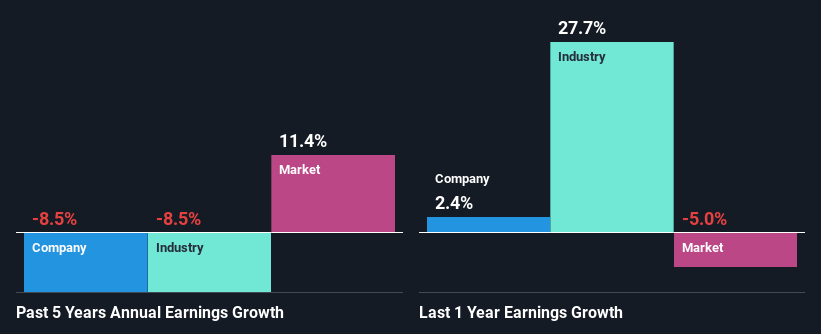Soup Holdings Limited's (SGX:5KI) Stock Has Shown Weakness Lately But Financial Prospects Look Decent: Is The Market Wrong?
Soup Holdings (SGX:5KI) has had a rough three months with its share price down 8.9%. However, the company's fundamentals look pretty decent, and long-term financials are usually aligned with future market price movements. In this article, we decided to focus on Soup Holdings' ROE.
Return on Equity or ROE is a test of how effectively a company is growing its value and managing investors’ money. In simpler terms, it measures the profitability of a company in relation to shareholder's equity.
See our latest analysis for Soup Holdings
How Do You Calculate Return On Equity?
The formula for ROE is:
Return on Equity = Net Profit (from continuing operations) ÷ Shareholders' Equity
So, based on the above formula, the ROE for Soup Holdings is:
15% = S$1.7m ÷ S$12m (Based on the trailing twelve months to June 2023).
The 'return' is the amount earned after tax over the last twelve months. That means that for every SGD1 worth of shareholders' equity, the company generated SGD0.15 in profit.
What Is The Relationship Between ROE And Earnings Growth?
Thus far, we have learned that ROE measures how efficiently a company is generating its profits. We now need to evaluate how much profit the company reinvests or "retains" for future growth which then gives us an idea about the growth potential of the company. Assuming all else is equal, companies that have both a higher return on equity and higher profit retention are usually the ones that have a higher growth rate when compared to companies that don't have the same features.
Soup Holdings' Earnings Growth And 15% ROE
At first glance, Soup Holdings seems to have a decent ROE. Especially when compared to the industry average of 6.6% the company's ROE looks pretty impressive. For this reason, Soup Holdings' five year net income decline of 8.5% raises the question as to why the high ROE didn't translate into earnings growth. Therefore, there might be some other aspects that could explain this. These include low earnings retention or poor allocation of capital.
Next, on comparing with the industry net income growth, we found that Soup Holdings' earnings seems to be shrinking at a similar rate as the industry which shrunk at a rate of a rate of 8.5% in the same period.
The basis for attaching value to a company is, to a great extent, tied to its earnings growth. The investor should try to establish if the expected growth or decline in earnings, whichever the case may be, is priced in. This then helps them determine if the stock is placed for a bright or bleak future. One good indicator of expected earnings growth is the P/E ratio which determines the price the market is willing to pay for a stock based on its earnings prospects. So, you may want to check if Soup Holdings is trading on a high P/E or a low P/E, relative to its industry.
Is Soup Holdings Making Efficient Use Of Its Profits?
With a high three-year median payout ratio of 65% (implying that 35% of the profits are retained), most of Soup Holdings' profits are being paid to shareholders, which explains the company's shrinking earnings. The business is only left with a small pool of capital to reinvest - A vicious cycle that doesn't benefit the company in the long-run. You can see the 4 risks we have identified for Soup Holdings by visiting our risks dashboard for free on our platform here.
In addition, Soup Holdings has been paying dividends over a period of at least ten years suggesting that keeping up dividend payments is way more important to the management even if it comes at the cost of business growth.
Summary
Overall, we feel that Soup Holdings certainly does have some positive factors to consider. Although, we are disappointed to see a lack of growth in earnings even in spite of a high ROE. Bear in mind, the company reinvests a small portion of its profits, which means that investors aren't reaping the benefits of the high rate of return. So far, we've only made a quick discussion around the company's earnings growth. To gain further insights into Soup Holdings' past profit growth, check out this visualization of past earnings, revenue and cash flows.
Have feedback on this article? Concerned about the content? Get in touch with us directly. Alternatively, email editorial-team (at) simplywallst.com.
This article by Simply Wall St is general in nature. We provide commentary based on historical data and analyst forecasts only using an unbiased methodology and our articles are not intended to be financial advice. It does not constitute a recommendation to buy or sell any stock, and does not take account of your objectives, or your financial situation. We aim to bring you long-term focused analysis driven by fundamental data. Note that our analysis may not factor in the latest price-sensitive company announcements or qualitative material. Simply Wall St has no position in any stocks mentioned.

 Yahoo Finance
Yahoo Finance 
